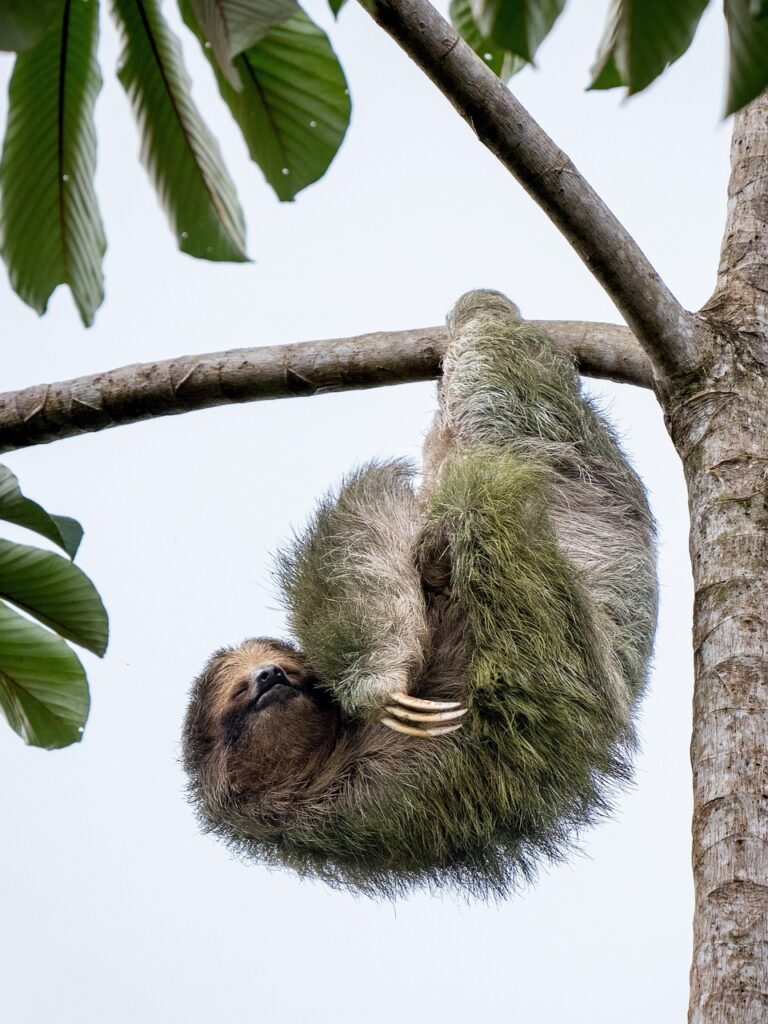Enjoy a leisurely walk searching for sloths sleeping high in the trees. An exciting tour for the whole family.
Tours start and finish in Puerto Jimenez.
Prices are based on a minimum of two people. Contact us to inquire about about available dates, and half-day or night tours.
Sloth Garden Stroll
- 8:00 AM - 11:00 AM; 1:00 PM - 4:00 PM
- Low Difficulty
- $80 per person + taxes


What’s Included
- Sloth Garden entrance fees
- Water and Snacks
- Local naturalist guide
What’s not Included
- Transport to and from Sloth garden
- Lunch
Sloth Search: A Peaceful Jungle Walk for the Whole Family
Join us for a relaxed and unforgettable three-hour jungle walk on the Osa Peninsula, where the stars of the show are two of Costa Rica’s most beloved creatures: the two-toed and three-toed sloths. Offered in both the morning (8–11 AM) and afternoon (1–4 PM), this tour is perfect for nature lovers of all ages—no hiking boots or intense trekking required.
We’ll meander through lush rainforest trails, where your naturalist guide will help you tune into the slower rhythms of the jungle. With their expert eye, you’ll learn how to spot sloths high in the treetops—camouflaged in the leaves, napping in the crook of a branch, or slowly making their way from tree to tree. While sloths can be elusive, this area is a known favorite for both species, and sightings are almost guaranteed.
Along the way, we’ll also point out colorful birds, frogs, insects, and maybe even a monkey or two, giving you a full taste of the Osa’s world-famous biodiversity. Whether you’re traveling solo, with your partner, or as a family with curious kids in tow, this gentle walk offers the perfect mix of discovery, education, and relaxation.
Come take it slow with us—you never know what you might see when you move at sloth speed.
Morning Sloth Garden Itinerary
8:00 AM Meet at the agreed meeting point
1:00 AM end of tour, Return to meeting point
Afternoon Sloth Garden Itinerary
1:00 pM Meet at the agreed meeting point
4:00 PM end of tour, Return to meeting point

What to bring on your adventure
- Hiking shoes or close-toed shoes (protected, comfortable, and preferably waterproof).
- Light and quick dry clothes
- Hat
- Sunglasses
- Sunblock.
- Bug repellent.
- Waterproof bag.
Optional:
- Binoculars.
- Camera.
- Sunglasses.
- Handkerchief.

Meet the Two Sloths of the Osa Peninsula: Nature’s Slow-Moving Wonders
Costa Rica’s Osa Peninsula is home to some of the richest biodiversity on the planet—including two of its most iconic and beloved residents: the two-toed sloth (Choloepus hoffmanni) and the three-toed sloth (Bradypus variegatus). These charming creatures live life in the slow lane, literally, and getting a glimpse of them in the wild is a highlight for many visitors.
The Three-Toed Sloth: The Classic Charmer
The three-toed sloth, with its distinctive permanent “smile,” is the smaller and more commonly spotted of the two. It has a rounded head, a lighter face, and, of course, three claws on each limb. These sloths are diurnal (active during the day), which increases your chances of seeing one during a tour.
Three-toed sloths are incredibly slow-moving, averaging just 0.24 kilometers per hour. But this isn’t laziness—it’s strategy. Their sluggishness helps them conserve energy and avoid detection by predators like harpy eagles and jaguars. Their coarse fur often hosts entire ecosystems of its own, including algae, beetles, and even moths, giving them a greenish tint that helps them blend into the rainforest canopy.
They are strictly folivores, feeding mostly on leaves, and they spend almost their entire lives in trees, coming down only about once a week to defecate—a risky trip that’s still one of nature’s great mysteries.
The Two-Toed Sloth: The Nighttime Navigator
The two-toed sloth is larger, fluffier, and a bit more elusive. With a longer snout and a more pigmented face, it has a different vibe than its three-toed cousin. This species is nocturnal and more agile, making it trickier to spot during the day. But if you catch a nighttime tour or are up early, you might be lucky.
Unlike the strict leaf diet of the three-toed sloth, two-toed sloths are omnivorous. They munch on leaves, fruits, flowers, and occasionally even small insects or bird eggs. This varied diet gives them a slight edge in terms of adaptability.
They’re also a bit speedier (for a sloth), capable of using their strong limbs and hooked claws to hang upside down for hours. In fact, they even sleep, eat, and give birth while hanging from branches.
Habitat & Fun Facts
Both sloth species thrive in the lush rainforests of the Osa Peninsula, especially in areas with dense tree cover and abundant food sources. Primary forests, secondary growth, and even some farm edges serve as their peaceful homes.
Fun fact #1: Sloths have more neck vertebrae than any other mammal, which means they can turn their heads a whopping 270 degrees—almost owl-like!
Fun fact #2: Despite their reputation for slowness, sloths are surprisingly good swimmers and will sometimes cross rivers to reach new trees.
Fun fact #3: A sloth’s fur ecosystem helps camouflage it and may even offer health benefits, like protection from parasites.